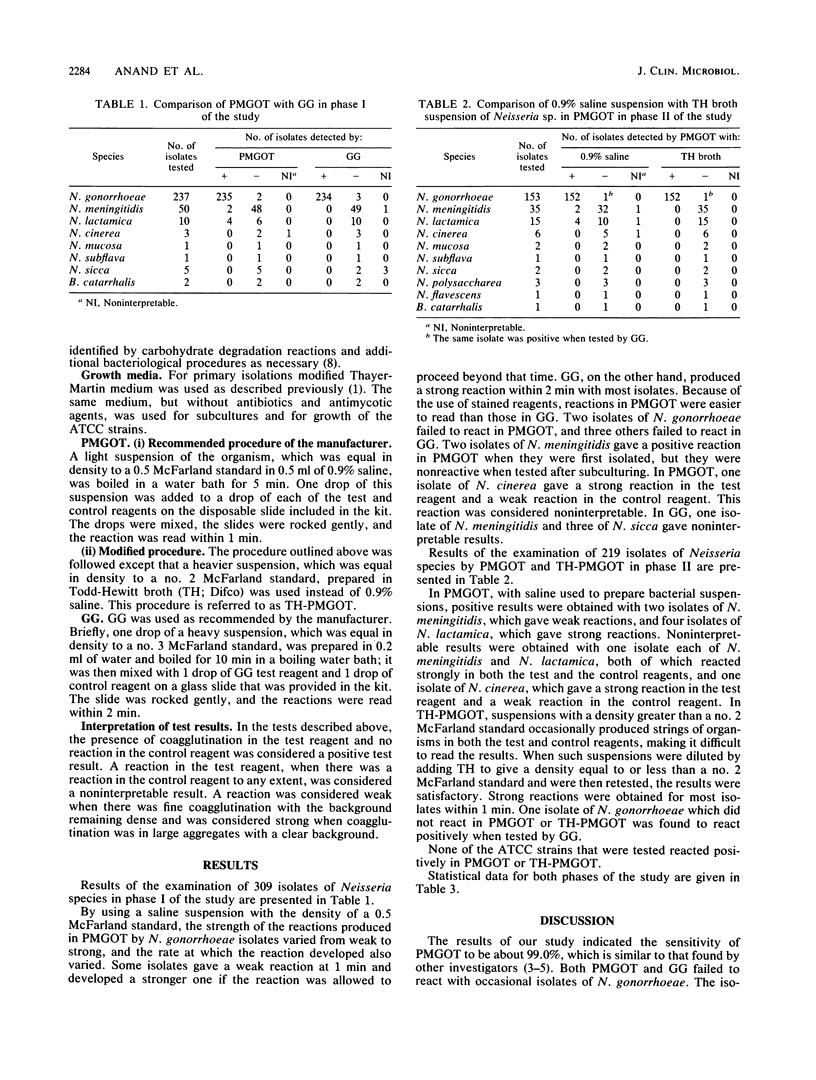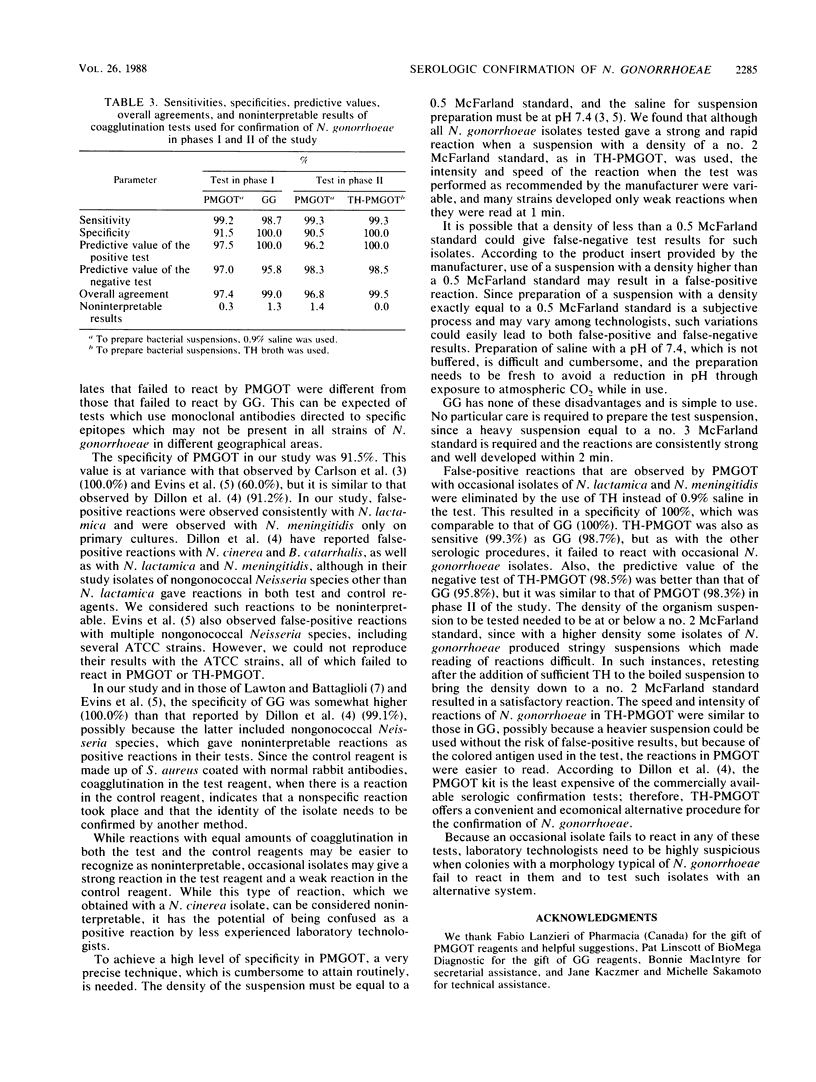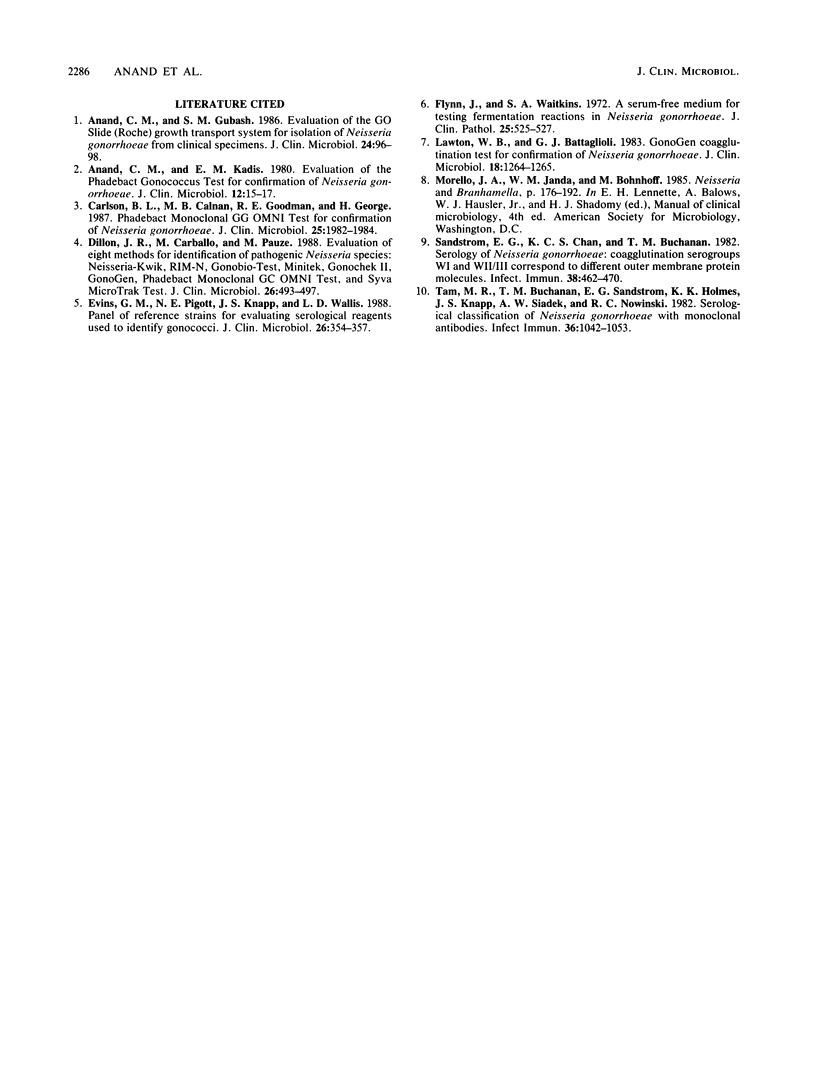Abstract
Two commercially available monoclonal antibody coagglutination tests, Phadebact Monoclonal GC OMNI Test (PMGOT; Pharmacia Diagnostics AB, Uppsala, Sweden) and GonoGen (GG; New Horizons Diagnostics, Columbia, Md.), for the confirmation of Neisseria gonorrhoeae were evaluated. The sensitivities of PMGOT and GG were 99.2 and 98.7% and the specificities were 91.5 and 100.0%, respectively. False-positive reactions were observed with Neisseria lactamica and Neisseria meningitidis in PMGOT. A modification of the procedure recommended by the manufacturer for PMGOT was done by substituting Todd-Hewitt broth for 0.9% saline to prepare the suspension of the test organism. This eliminated technical difficulties with the test and resulted in a sensitivity and a specificity of 99.3 and 100.0%, respectively. Advantages offered by the modified PMGOT over GG were the better predictive value of the negative test, the lower cost, the ease of reading of the test, and the lack of noninterpretable results.
Full text
PDF



Selected References
These references are in PubMed. This may not be the complete list of references from this article.
- Anand C. M., Gubash S. M. Evaluation of the GO Slide (Roche) growth transport system for isolation of Neisseria gonorrhoeae from clinical specimens. J Clin Microbiol. 1986 Jul;24(1):96–98. doi: 10.1128/jcm.24.1.96-98.1986. [DOI] [PMC free article] [PubMed] [Google Scholar]
- Anand C. M., Kadis E. M. Evaluation of the Phadebact Gonococcus Test for confirmation of Neisseria gonorrhoeae. J Clin Microbiol. 1980 Jul;12(1):15–17. doi: 10.1128/jcm.12.1.15-17.1980. [DOI] [PMC free article] [PubMed] [Google Scholar]
- Carlson B. L., Calnan M. B., Goodman R. E., George H. Phadebact Monoclonal GC OMNI Test for confirmation of Neisseria gonorrhoeae. J Clin Microbiol. 1987 Oct;25(10):1982–1984. doi: 10.1128/jcm.25.10.1982-1984.1987. [DOI] [PMC free article] [PubMed] [Google Scholar]
- Dillon J. R., Carballo M., Pauzé M. Evaluation of eight methods for identification of pathogenic Neisseria species: Neisseria-Kwik, RIM-N, Gonobio-Test, Minitek, Gonochek II, GonoGen, Phadebact Monoclonal GC OMNI Test, and Syva MicroTrak Test. J Clin Microbiol. 1988 Mar;26(3):493–497. doi: 10.1128/jcm.26.3.493-497.1988. [DOI] [PMC free article] [PubMed] [Google Scholar]
- Evins G. M., Pigott N. E., Knapp J. S., DeWitt W. E. Panel of reference strains for evaluating serologic reagents used to identify gonococci. J Clin Microbiol. 1988 Feb;26(2):354–357. doi: 10.1128/jcm.26.2.354-357.1988. [DOI] [PMC free article] [PubMed] [Google Scholar]
- Flynn J., Waitkins S. A. A serum-free medium for testing fermentation reactions in Neisseria gonorrhoeae. J Clin Pathol. 1972 Jun;25(6):525–527. doi: 10.1136/jcp.25.6.525. [DOI] [PMC free article] [PubMed] [Google Scholar]
- Lawton W. D., Battaglioli G. J. Gono Gen coagglutination test for confirmation of Neisseria gonorrhoeae. J Clin Microbiol. 1983 Nov;18(5):1264–1265. doi: 10.1128/jcm.18.5.1264-1265.1983. [DOI] [PMC free article] [PubMed] [Google Scholar]
- Sandstrom E. G., Chen K. C., Buchanan T. M. Serology of Neisseria gonorrhoeae: coagglutination serogroups WI and WII/III correspond to different outer membrane protein I molecules. Infect Immun. 1982 Nov;38(2):462–470. doi: 10.1128/iai.38.2.462-470.1982. [DOI] [PMC free article] [PubMed] [Google Scholar]
- Tam M. R., Buchanan T. M., Sandström E. G., Holmes K. K., Knapp J. S., Siadak A. W., Nowinski R. C. Serological classification of Neisseria gonorrhoeae with monoclonal antibodies. Infect Immun. 1982 Jun;36(3):1042–1053. doi: 10.1128/iai.36.3.1042-1053.1982. [DOI] [PMC free article] [PubMed] [Google Scholar]


